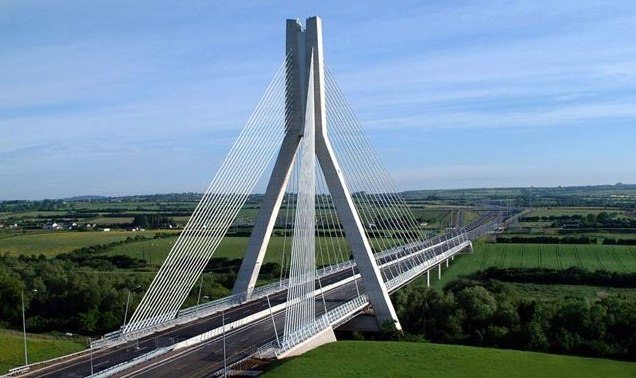Important Definitions in Bridge Engineering

1. Bridge : Bridge is a structure having a total length of above 6 m between the inner faces of the dirt walls for carrying traffic or other moving loads over a depression or obstruction such as channel, road or railway. These bridges are classified as :
- Small bridge – Overall length of the bridge between the inner faces of dirt walls is up to 30m and where individual span is not more than 10m
- Minor bridge – Total length up to 60m
- Major bridge – Total length greater than 60m
2. Culvert : A cross drainage structure having total length of 6 m or less between inner faces of dirt wall.
3. Foot Bridge : A bridge extensively used for carrying pedestrians, cycles and animals.
4. High Level Bridge : A bridge, which carries the roadway above H.F.L. of the channel.
5. Submersible Bridge/Vented Causeway : A bridge designed to be over-topped during floods.
6. Channel : A natural or artificial watercourse.
7. Clearance : The shortest distance between boundaries at a specified position of bridge structure.
8. Freeboard : The difference between H.F.L. (allowing afflux) and foundation level of road embankment on approaches.
9. H.F.L. : Highest flood level is the level of highest flood ever recorded or the calculated level for design discharge.
10. L.W.L. : Lowest flood level is the level of the water surface obtained in dry season.
11. Length of Bridge : The length of a bridge structure will be taken as overall length measured along the center line of the bridge between inner faces of dirt wall.
12. Linear Waterway : Width of waterway between the extreme edges of water surface at H.F.L. measured at right angles to the abutment face.
13. Effective Linear : The total width of the waterway of the bridge at H.F.L. minus Waterway effective width of obstruction.
14. Safety Kerb : A roadway kerb for occasional use of pedestrian traffic.
15. Width of Carriageway: Minimum clear width measured at right angles to the longitudinal centre line of bridge between inside faces of roadway kerb or wheel grades.
16. Super elevation/Cant/Banking : The transverse inclination given to the c/s of a carriageway on a horizontal curve in order to reduce the effects of centrifugal force on a moving vehicle.
17. Vertical clearance : The height from the design highest flood level with afflux of the channel to the lowest point of the bridge superstructure at the position along the bridge where clearance is denoted.
